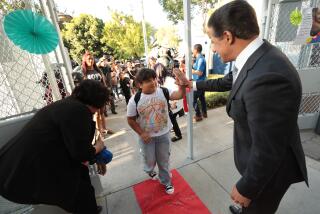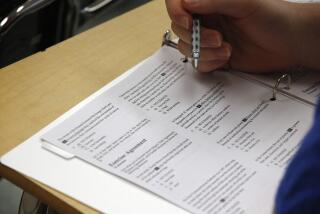Everything I Really Need to Know I Learned in Helsinki
- Share via
One of the many complaints about schooling is that we are failing to prepare students for the technical demands of the global economy. We import computer specialists from India, outsource our engineering and fear China and its competitive education system.
Meanwhile, the U.S. ranks about average on math and science tests administered to 15-year-olds in 41 countries by the Program for International Student Assessment, or PISA.
Our literacy scores are also average, and highly unequal. California is worse. Scores on the National Assessment of Educational Progress, the “nation’s report card,” place us 47th in eighth-grade math and tied for last in both science and reading. This kind of performance doesn’t prepare us for the global economy.
The decline of California’s education system has taken several decades, and so will a revival. The nation -- and California -- will have to spend more on education, schools and personnel, but it also desperately needs a vision and a stable plan to guide this investment.
I have just returned from studying Finland’s education system. According to PISA scores, this country of 5 million people ranks second (to South Korea) in math, third (to Japan and South Korea) in science and first in literacy by a substantial margin. Variations among Finnish students on these tests were the lowest or near the lowest.
To accomplish this, Finland has developed interlocking practices that foster both high and equitable performance. If a student starts falling behind his peers or grade norms, the teacher works with him one on one, or in small groups. Another approach involves a school assistant who may sit beside the student in class to provide help and encouragement, or work one on one or in small groups with him. The third approach involves a special-needs teacher -- not a special-education teacher, but a credentialed teacher with additional preparation in learning difficulties. The fourth line of attack is to send in a multidisciplinary team, including school personnel, social workers, representatives of the health and mental health systems as necessary and perhaps individuals from public housing. If non-school problems are solved by other professionals, teachers are free to concentrate on instruction.
This four-pronged approach depends on other features of the Finnish system: Small class sizes and small schools make it easier to diagnose learning problems. Teachers keep the same students for several years and get to know them. Thorough training develops teachers with expertise in their subject matter and pedagogical alternatives. A strong welfare system -- nutrition, housing, healthcare and family services -- complements schooling.
The Finns do not rely on excessive low-level testing, as the U.S. does. They have explicitly rejected the “naming and shaming” that goes on in American schools through the publishing of test scores. Test scores are never made public. They are used for diagnosis and improvement only, not for invidious comparisons or to excoriate teachers, demean students or identify the worst performing groups.
Obviously, California cannot simply copy Finnish values and practices, or its small size, or its strong welfare state. But it can use some of its educational practices as guides. Until we start moving in this direction, California and the nation will lag behind our competitors in subjects crucial to the global economy, and our children will be left behind.






